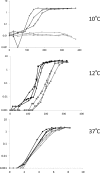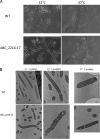The CasKR two-component system is required for the growth of mesophilic and psychrotolerant Bacillus cereus strains at low temperatures
- PMID: 24509924
- PMCID: PMC3993181
- DOI: 10.1128/AEM.00090-14
The CasKR two-component system is required for the growth of mesophilic and psychrotolerant Bacillus cereus strains at low temperatures
Abstract
The different strains of Bacillus cereus can grow at temperatures covering a very diverse range. Some B. cereus strains can grow in chilled food and consequently cause food poisoning. We have identified a new sensor/regulator mechanism involved in low-temperature B. cereus growth. Construction of a mutant of this two-component system enabled us to show that this system, called CasKR, is required for growth at the minimal temperature (Tmin). CasKR was also involved in optimal cold growth above Tmin and in cell survival below Tmin. Microscopic observation showed that CasKR plays a key role in cell shape during cold growth. Introducing the casKR genes in a ΔcasKR mutant restored its ability to grow at Tmin. Although it was first identified in the ATCC 14579 model strain, this mechanism has been conserved in most strains of the B. cereus group. We show that the role of CasKR in cold growth is similar in other B. cereus sensu lato strains with different growth temperature ranges, including psychrotolerant strains.
Figures





References
-
- Guinebretiere MH, Auger S, Galleron N, Contzen M, De Sarrau B, De Buyser ML, Lamberet G, Fagerlund A, Granum PE, Lereclus D, De Vos P, Nguyen-The C, Sorokin A. 2013. Bacillus cytotoxicus sp. nov. is a novel thermotolerant species of the Bacillus cereus group occasionally associated with food poisoning. Int. J. Syst. Evol. Microbiol. 63:31–40. 10.1099/ijs.0.030627-0 - DOI - PubMed
-
- Guinebretiere MH, Velge P, Couvert O, Carlin F, Debuyser ML, Nguyen-The C. 2010. Ability of Bacillus cereus group strains to cause food poisoning varies according to phylogenetic affiliation (groups I to VII) rather than species affiliation. J. Clin. Microbiol. 48:3388–3391. 10.1128/JCM.00921-10 - DOI - PMC - PubMed
-
- Brillard J, Broussolle V. 2012. Mechanisms involved in low-temperature adaptation in Bacillus cereus, p 125–145 In Requena JM. (ed), Stress response in microbiology. Caister Academic Press, Norfolk, United Kingdom
Publication types
MeSH terms
Substances
LinkOut - more resources
Full Text Sources
Other Literature Sources
Molecular Biology Databases

